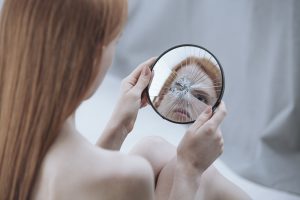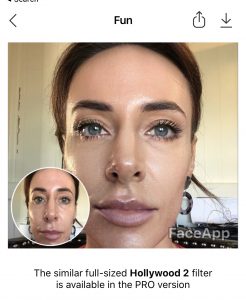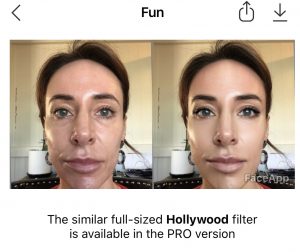When you look in the mirror, do you see only the things that are wrong with your face?
Written by Anita East – owner and clinical director of Anita East Medispa

At the recent Aesthetic Medicine World Congress (AMWC) in Monaco, there was a definite undercurrent of concern amongst attendees about the ever-growing prevalence of Body Dysmorphic Disorder (BDD) or as recently labelled, Snapchat Dysmorphia.
Aesthetic Medicine professionals from all over the globe, agreed that Women and Men are now so obsessed with the complexion smoothing and face beautification filters of Snapchat and Instagram, that they are trying to get the look recreated in real life. Gone are the days when our patients aspired to have Natalie Portman’s jawline or Angelina Jolie’s lips. Now patients bring in pictures of themselves or of an ‘influencer’s’ heavily filtered face, when explaining to their clinician how they want to look.
Selfies
Discussing the impact of the ‘selfie’, Northwestern University psychology professor Renee Engeln during a TEDx talk said, “Our sense of what’s real, what’s possible when it comes to beauty, is warped by our overexposure to these (unrealistic) images.” In 2017, a survey conducted by the American Academy of Facial Plastic and Reconstructive Surgery (AAFPRS), found that over half of all patients sought plastic surgery to improve how they looked in selfies. This is a startling and extremely concerning statistic.
A decade ago, it was likely that we encountered one or two patients with unrealistic expectations of what could be achieved from cosmetic medicine enhancements, today though, and thanks to the huge influence of social media, we would be hard pressed to find one or two patients who didn’t have some degree of unrealistic expectation fuelled by body dysmorphia.
The presence of heavy filtering apps in social media, is changing the way people actually look in photographs. Patrick Byrne, AAFPRS said, social media has “caused patients to become very critical of themselves and others.” He explains, “they are wanting to ‘fine tune’ things we would have never seen before the world of the ‘selfie.’”
Face Filters
The rise of heavy editing apps such as Facetune, which allows users up to 20 different face beautifying alternatives for one selfie, is at the root of Snapchat Dysmorphia. At my Cosmetic Medicine clinic in Brisbane, over the last 24 months I have seen a sharp and worrying increase in women from ages 20-60 years, who are being influenced negatively by these untruthful and heavily edited images. It is leading to unrealistic expectations of what is achievable from cosmetic enhancement treatments. Sadly, these women and men are being sucked into a lie. They believe that how they or someone else looks in a face tuning and enhanced photograph, is possible to look like in real life.
I took this test myself, just to see how transformational the face filters are. I took a photo of me at my desk, writing this article and having just woken up. The results speak for themselves!!
Before and After using FaceApp Hollywood filter.


Wow, me with no makeup & having just woken up in the before photo and after applying the ‘Hollywood filter’ I am fully glamourous. I didn’t even have to lift a finger, let alone spend 5 hours getting ready.
Amazing, yes! But NOT REAL!
Case Study – Body Dysmorphia
I remember one of my very first patients with body dysmorphia. It was the era before social media. A professional, intelligent and well-presented woman in her early forties and convinced that she was losing volume in her cheeks at an alarming rate, sought my professional advice. My diagnosis was that she had been over treated previously and now had worryingly over-filled cheeks.
The woman scheduled in weekly appointments with me and when quizzed by reception staff as to why she needed such regular treatments, she evaded the question by saying that they were for different procedures. However, each Friday she came with the same request “my cheeks need to be filled”, and repeatedly I asked her to show me where her cheeks had become flat from the previous week. She would look in the mirror and point to imaginary flat spots. I would reply that I couldn’t see any flat areas and that I felt her cheeks were already very volumous and did not need further filling. She would walk around my treatment room, searching in the handheld mirror and blaming the lighting for my inability to see what was glaringly obvious to her. Every week I empathetically told her “I only treat what I can see and if I cannot see it, I cannot treat it”.
Over her next few appointments, the woman became increasingly frustrated with me for not being able to see her “flat cheeks”. I continued to refuse to treat her and asked that we stretch out her next appointment to six months rather than the following week. I talked to her about body dysmorphia, what it meant and how it felt to have it. She agreed that she spent an above average amount of time staring at her flaws in the mirror but denied it negatively affected her.
I offered to refer her to a counsellor or psychologist and asked her to visit her G.P for advice. She refused and told me that she could easily go elsewhere for treatment and that money was no concern to her. I agreed this was true and that sadly other clinicians would have less regard for her mental welfare and happily treat her. I explained why this wasn’t ideal for her.
She never did return. I heard that she successfully sought and was given treatment by another clinician who operated close by. Over a decade on, I often think about her now and wonder how she is coping with the impact of social media and Snapchat Dysmorphia. I hope someone has managed to positively impact her mental health during these trying times.
Do you have ‘Snapchat Dysmorphia’?
- Do you obsess over imaginary or real imperfections you see in the mirror or in photographs?
- Do you believe that the images on social media and in the media in general, are true and honest representations of how people look in real life?
- Do you desire to aspire to look like these images when you know these images are edited and photographically enhanced?
*If you feel like you do have some or all of the BDD indicators, please seek help from your GP or ask your cosmetic medicine specialist to refer you to a trusted counsellor or psychologist.
Anita East Medispa

Anita East wears three much loved and firmly fitting hats. Aesthetic Medicine expert, author and performer.
First and foremost she is the author of Beautiful Unique Faces: The book ripping apart society’s expectation of perfection in beauty. Managing Director and Clinical Director (Cosmetic Nurse Practitioner) of Anita East Medispa. We’ll care for & empower you so you can be the best you can be. Anita is determined to make the world a safer and more accepting place for when her two darling daughters grow up and ask: “Am I beautiful enough?”
At Anita East Medispa, Aesthetic Excellence is delivered by the whole AE Medispa team.
Contact us on 0413 231 100, info@anitaeast.com.au, www.anitaeast.com.au
Anita Clements – (stage name) is an Actress with extensive TV, Film, Theatre and Presenting experience in UK and Australia. Anita is also a resident columnist for UK based, The Cosmetic Surgery Magazine.
Contact me on 0422 852 877, anitaclements@me.com, www.anitaclements.com
Fantastic article Anita, and so scarily true. Thankyou for sharing your thoughts and experiences, and for leading the way in helping people to feel beautiful within themselves.